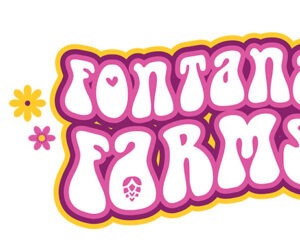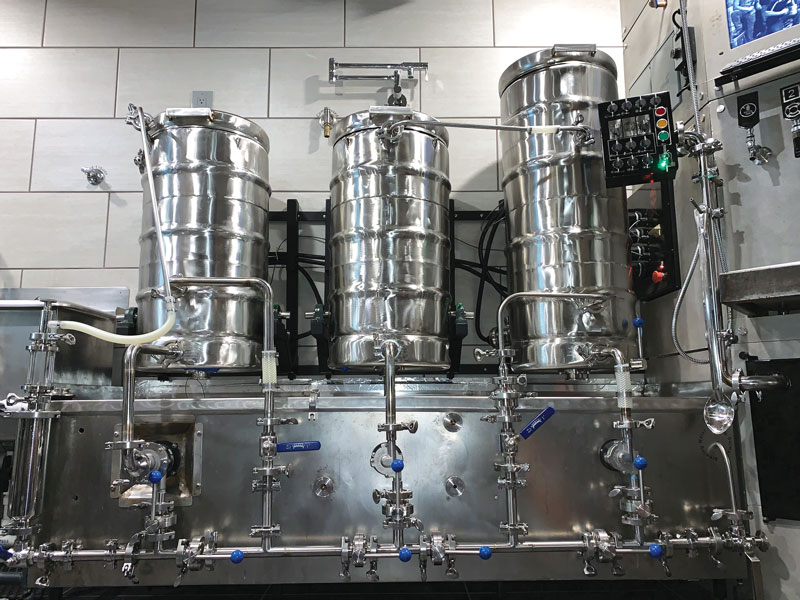Confluence Brewing Co.
Dear Replicator,
My wife and I were heading out for a trip to visit an old friend in Fort Collins, Colorado and our first big stop was in Des Moines, Iowa. Being beer lovers, we did a search for breweries in Des Moines for some beers before our dinner reservation. A place called Confluence Brewing Co. popped up and after doing some more research we decided this would be our first brewery of the trip. While we loved their small-batch beers, the one that truly stood out, surprisingly to me, was their Blue Corn Lager. The flavors and aroma were amazingly complex for a simple lager. Can you help with a recipe for this beer?
Dan Geary
Lake Forest, Illinois
The professional brewing dream is alive and well, and not just in Big City, USA.
John Martin was a farm boy from Imogene, Iowa who had the same dream. Walking through the cornfields, Martin imagined what it might be like to turn these grains into beer.
In high school and while studying physics in college, Martin tried homebrewing, but had neither the knowledge nor the equipment to be successful at a consistently high level. Undeterred, he found information online and in books prior to graduating college that helped improve his processes. In 1995, Martin married a very supportive wife, Katie, who encouraged him to purchase good homebrewing equipment with some of the couple’s wedding money. (Katie’s clearly a keeper in my book.)
Now armed with a top-notch brewing system and a degree in physics, Martin didn’t initially pursue either. He went into the construction business, at one point opening his own company.

Despite the lucrative new career, Martin’s heart was still drawn to brewing. By 2012, through much trial and error, he had become a very adept brewer and knew the time had come to see his dream into reality.
Martin connected with fellow beer lover Ken Broadhead, and the two began to conceptualize and eventually build a brewery. While not an active partner in the business, Broadhead helped push Martin forward with ideas, inspiration, and motivation. One of the many Broadhead contributions was the name Confluence Brewing Co.
By definition, a confluence occurs when two or more bodies of water (typically rivers) come together to form a single body of water. Martin envisioned other confluences — such as beer ingredients, people, and ideas — coming together, which ultimately inspired the brewery’s tagline “Where good things come together.” Confluence Brewing opened in October of 2012, just south of downtown Des Moines, Iowa where the Des Moines and Racoon rivers meet. “It was important for us to be a Des Moines brewery,” said Martin. “It’s who we are and we are proud of that.”
Producing upwards of 100 different beers in 2020, the workhorse Head Brewer/Co-Founder Martin, along with Production Manager Josh Maxson and Lead Brewer Andrew Bishop (formerly of Maine’s Allagash Brewing Co.) run the gamut of flavors, colors, and styles.
The popular Des Moines IPA, a local favorite, makes up about 40% of the brewery’s total sales. “As a homebrewer, I often brewed a beer called Hop Head Extreme,” said Martin. “I just kept working on the recipe until it was what I envisioned. When we opened, I changed the name to Des Moines IPA to celebrate the local community.”
Along with the popular IPA, Vienna lager, milk stout, and many other favorites, another interesting beer in the lineup is the Blue Corn Lager, a yearly specialty that hits taps in early May.
No doubt, Iowa is known for its corn, but not necessarily blue corn. So why would a brewery, surrounded by all the corn it could possibly want, outsource all the way to New Mexico for blue corn?
“I wanted to have fun with it,” said Martin. “Blue Corn Lager is made like a classic American Pilsner with a twist. Blue corn makes a sweet wort, with a little bit of that corn chip flavor.”
The corn is run through the grain mill to open up the starches. Then, a bag of Pilsner malt is added to it to give it the proper enzymes needed for conversion. It’s boiled for a half hour where it turns into a purple porridge. It’s cooled with cold water to get back to a protein rest temperature. The rest of the grist is added to this gelatinized corn and, during the brewing process, the purple color magically disappears.
“We aim to hit 122 °F (50 °C) for a protein rest then raise the temperature to 147 °F (64 °C) where we hold it for about 45 minutes to produce a very fermentable wort,” said Martin. “The goal is to do a protein rest on both the corn and the malt. Some argue it may not be necessary, but I feel it gives the beer complexity and a better body.”
The grain bill is made up of mostly Pilsner malt, two kinds specifically, and some wheat and Carahell® to add additional complexity. A combination of traditional Czech Saaz and New Zealand MotuekaTM hops, sometimes called “Belgian Saaz,” are used to balance the malt and corn sweetness.
“German Weyermann Pilsner malt is almost too rich to be used alone, so I also use a U.S. Pilsner malt to cut back some of the rich sweetness,” said Martin.
The beer is carbonated to 2.6 volumes and served in a traditional Pilsner glass. Blue Corn Lager pairs amazingly well with Mexican food.
“We hope this refreshing beer proves that adjunct lagers have a place in the craft beer world,” said Martin.
Confluence Brewing Co.’s Blue Corn Lager clone

(5 gallons/19 L, all-grain)
OG = 1.059 FG = 1.011
IBU = 20.5 SRM = 4 ABV = 6.2%
Ingredients
2.4 lbs. (1.1 kg) Sunny State Products Heritage Organic Blue Corn
4.4 lbs. (2 kg) Rahr Premium Pils malt
4.4 lbs. (2 kg) Weyermann Pilsner malt
7 oz. (200 g) Weyermann pale wheat malt
4 oz. (113 g) Weyermann acidulated malt
4 oz. (113 g) Weyermann Carahell® malt
6 oz. (170 g) rice hulls (optional)
2.1 AAU Czech Saaz hops (60 min.) (0.4 oz./11 g at 5.3% alpha acids)
2.2 AAU Motueka™ hops (60 min.) (0.45 oz./13 g at 4.9% alpha acids)
1 g Yeastex 82 (or equivalent yeast nutrient) (15 min.)
1 g Whirlfloc (or ½ tablet) (15 min.)
Wyeast 2142 (Bohemian Lager), White Labs WLP830 (German Lager), or Mangrove Jack’s M84 (Bohemian Lager) yeast
¾ cup corn sugar (if priming)
Step by Step
Cereal mash: Mill blue corn and 0.9 lbs. (0.41 kg) Rahr Pilsner malt and mash in with 5.5 quarts (5.2 L) of water to achieve a rest at 150 °F (66 °C). Let rest for 15 minutes, then raise to a boil and boil for 30 minutes. Let cool to 120–130 °F (49–54 °C) or add some cold strike water to cool.
Main mash: With the cereal mash, add an additional 3.25 gallons (12.3 L) of water and mash-in remaining malt, shooting for 122 °F (50 °C) for a protein rest. Rest for 15 minutes, then raise to 147 °F (64 °C) and hold for 60 minutes. Mash out at 170 °F (77 °C). Sparge with water acidified to pH 5.7 at 170 °F (77 °C) and collect 6.8 gallons (26 L) of wort. Boil for 30 minutes before adding the hops.
When the 90-minute boil is finished, cool wort to 50 °F (10 °C). This beer requires a healthy pitch of yeast. Aim for 1.25 million cells/mL/°P. Oxygenate or aerate well. Ferment at 50 °F (10 °C) until fermentation activity slows to a few bubbles per minute through the airlock. Let warm to 57 °F (14 °C) and hold for a few days. Slowly cool back to 50 °F (10 °C) and hold for a few more days. Cool the beer 3 °F/day (1.5 °C/day) to 38 °F (3.3 °C) and hold for 1–2 weeks to lager/condition. Keg and carbonate to 2.6 volumes of CO2.
Confluence Brewing Co.’s Blue Corn Lager clone
(5 gallons/19 L, partial mash)
OG = 1.059 FG = 1.011
IBU = 20.5 SRM = 4 ABV = 6.2%
Ingredients
4.5 lbs. (2 kg) Pilsen light dried malt extract
2.4 lbs. (1.1 kg) Sunny State Products Heritage Organic Blue Corn
0.75 lb. (0.34 kg) Pilsner malt
7 oz. (200 g) Weyermann pale wheat malt
4 oz. (113 g) Weyermann Carahell® malt
2.1 AAU Czech Saaz hops (60 min.) (0.4 oz./11 g at 5.3% alpha acids)
2.2 AAU Motueka™ hops (60 min.) (0.45 oz./13 g at 4.9% alpha acids)
1 g Yeastex 82 (or equivalent yeast nutrient) (15 min.)
1 g Whirlfloc (or ½ tablet) (15 min.)
Wyeast 2142 (Bohemian Lager), White Labs WLP830 (German Lager), or Mangrove Jack’s M84 (Bohemian Lager) yeast
¾ cup corn sugar (if priming)
Step by Step
Follow the same instructions as the all-grain recipe for the cereal mash. The key difference is to only cool the cereal mash after the boil to 150–160 °F (66–71 °C) with some cool water. Add the pale wheat and Carahell® malts and hold for 30 minutes at this temperature. Separate the liquid from the grains and corn and collect into a boil kettle.
Add an additional 2 gallons (7.6 L) of water and raise to near-boiling temperature. Remove from the heat source, slowly stir in extract to ensure it is fully dissolved. Return to heat source and boil for 30 minutes before adding hops. Follow the remaining all-grain instructions for post-boil, fermentation, and packaging directions.
Tips For Success:
For brewers that have a hard time sourcing blue corn, flaked white maize can be substituted and added directly to the mash since it is pre-
gelatinized. And, one type of Pilsner malt will suffice if your homebrew store doesn’t source multiple Pilsner malt options. U.S. Saaz or additional Czech Saaz can be used in place of Motueka™. Finally, for an interesting twist, a Mexican lager yeast can be used in place of a traditional lager yeast. However, following the recipe and instructions above will get you the closest possible replication to the original Blue Corn Lager.



